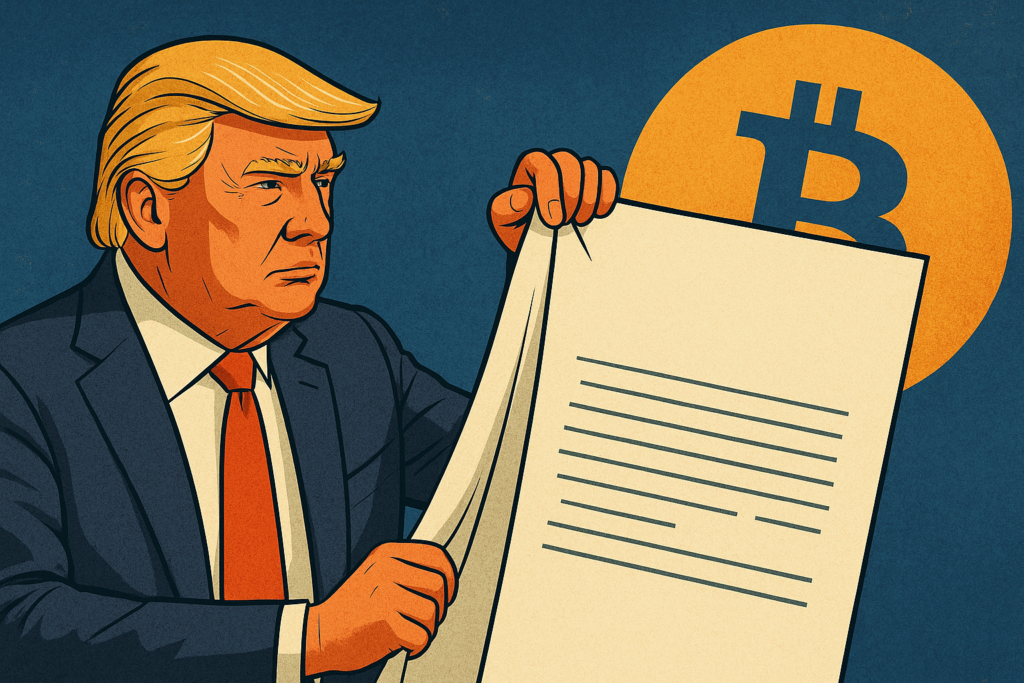
Trump’s Crypto Regulation Report: A Turning Point for U.S. Digital Assets?
The Trump administration has just released its long-promised crypto regulation report — and with it, a bold vision for the future of digital assets in the United States.
This isn’t just another policy paper. It could mark the beginning of a new chapter in the U.S. approach to digital assets — one where innovation is prioritized, investment is encouraged, and regulation serves as a foundation rather than a barrier.
Inside the Crypto Regulation Report
At the core of the report is a call for simplified, pro-growth regulation. The Trump team proposes clearer asset classification, a more transparent tax structure, and regulatory “sandboxes” for developers and startups.
The 160-page document lays out a framework that emphasizes:
- Clear asset classification: Simplifying the distinction between securities, commodities, and payment tokens
- Simplified taxation: Including favorable long-term capital gains treatment and clearer guidance for retail investors
- Innovation zones: Regulatory “sandboxes” to allow blockchain startups to grow without immediate enforcement
- Stablecoin oversight: Requiring full 1:1 backing and U.S. dollar reserve disclosures
- Combatting deplatforming: Including recommendations to prevent financial censorship by banks and tech firms
The report’s tone is “noticeably cooperative,” aiming to work with the industry instead of treating it like a threat. Rather than framing crypto as a risk to financial stability, the Trump team positions it as an opportunity — one that can be leveraged for national innovation, tech leadership, and financial inclusion.
The idea is to give the industry room to grow while establishing clear boundaries — not through heavy-handed enforcement, but through consistency and incentives. Notably, the report aligns with international models that have seen success, particularly in fostering fintech ecosystems in places like the UK and UAE.
Noteworthy Omission: No U.S. Bitcoin Reserve
Back in May 2025, Trump publicly announced plans to create a U.S. Strategic Crypto Reserve, positioning Bitcoin as a hedge against inflation and a pillar of digital sovereignty. Senior officials said that information could arrive later from the Treasury—but the omission was widely noted given earlier expectations
For many in the crypto community, this was a missed opportunity. While regulatory clarity is welcome, the absence of concrete steps toward a national crypto strategy or reserve policy raises questions about the administration’s follow-through — and whether true institutional adoption is still further off than hoped.
How the Market Reacted
Markets didn’t wait long to respond. Within hours of the report’s release, major crypto assets saw a brief but notable rally:
- After peaking at around $118,742, Bitcoin slipped to as low as $115,521 shortly following the report and Fed rate hold announcement, before finding support near $116,558—a decline of about 2.7% intraday.
- ETH held up better, showing modest gains and outperforming Bitcoin—helped by ongoing ETF inflows and optimism around future fund approvals.
Still, the reaction has been measured. Many investors are taking a wait-and-see approach, especially as it remains unclear whether the current administration will adopt or oppose the ideas in the report. But what is clear is that crypto regulation and market developments are increasingly linked — and this report has shifted sentiment in a more optimistic direction.
Trump and Crypto: A Complicated History Evolves
Donald Trump’s relationship with crypto has never been straightforward. In his first term, he made headlines for calling Bitcoin “a scam” and expressing skepticism about decentralized currencies. Yet in the years since, his tone has shifted — not dramatically, but noticeably. While never a vocal champion of crypto, he has shown increasing openness to digital assets as a tool for economic growth and national competitiveness.
The release of this new report reflects that evolution. Rather than dismissing crypto, it aims to integrate it — by establishing a regulatory framework that promises clarity without suffocating innovation. It’s a calculated move that speaks not just to changing market realities, but to Trump’s growing awareness of crypto’s role in shaping the future of finance.
Political Strategy Meets Economic Vision
Trump’s crypto regulation push is not just about markets — it’s about messaging. By presenting a framework focused on innovation, fairness, and global competitiveness, the former president is signaling a desire to reclaim U.S. leadership in blockchain and Web3.
For investors, this means the tides may be turning. For builders, it signals a less hostile regulatory environment. And for the broader public, it offers a glimpse of how digital assets might fit into the next phase of American economic policy — whether under Trump or as a pressure point on the current administration.
Conclusion: A Step Forward But Not the Full Picture
The Trump administration’s crypto regulation report is an important step toward a more mature, more structured digital asset ecosystem in the U.S. It brings much-needed clarity — and it puts crypto squarely on the national policy stage.
But questions remain. The absence of a Bitcoin reserve or national strategy leaves gaps in the vision.
What’s certain is that crypto is no longer an outsider in American politics — and this report may well be remembered as the moment that shifted the conversation from speculation to strategy.
As always, conduct your own research and consider your risk appetite before making any trading or investment decisions.
Don’t forget to follow us on X, LinkedIn,Telegram, Instagram and Facebook to stay updated with breaking crypto news, market insights, and key developments as they happen.

